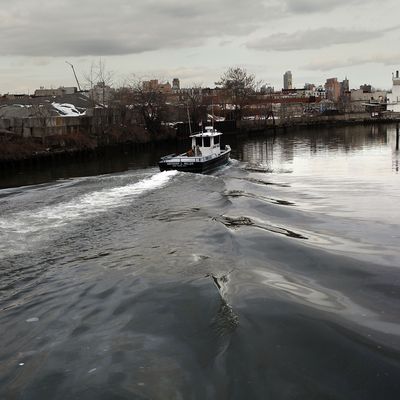
Looking out into the heavy rain on Monday morning, City Councilman Brad Lander was thinking about the Gowanus Canal. “Luckily I hadn’t eaten breakfast yet,” he said. That’s because heavy rain in Brooklyn means another day where overflow sewage flows into the polluted waterway.
Back in April, all Lander wanted was for the New York City Department of Environmental Protection and the U.S. Environmental Protection Agency to coordinate their efforts to clean up toxic waste and human-excrement-filled Gowanus Canal. Instead, his open letter has spawned an entirely different kind of shitstorm — a bureaucratic battle between the city and the feds about who is responsible for the canal’s pollution, and who is on the hook for cleaning it up.
There are two main types of nasty in the Gowanus: a nasty sludge of toxic industrial waste, a byproduct of more than a hundred years of industrial activity; and good old human excrement, quaintly known as “combined sewer overflow” (CSO), which manifests as an odorous brown tide of poo every time it rains. Ever since the Gowanus was declared a Superfund site two years ago over the opposition of Mayor Bloomberg, the EPA has been legally bound to clean up the toxic waste. The city’s DEP, meanwhile, has a separate “Long Term Control Plan” to address CSOs. However, if it turns out that CSOs are creating toxic by-products that are covered by the federal Superfund statue, the EPA can legally compel the city to pay for part of the cleanup.
A 2011 EPA study found that CSOs did contribute to the toxic Gowanus waste and named the City of New York as a “potentially responsible party” for cleanup. At a community board meeting last month, DEP representative Eileen Mahoney took issue with the EPA’s methodology and argued that “ … it has not yet been determined that the CSOs are contributing chemicals to the canal at levels that constitute unacceptable risks.”
The agencies are now in a series of technical negotiations about the fecal minutia. Natalie Loney, the Superfund Community Involvement Coordinator, said that the EPA is “not above reproach” in its methods, and is seriously considering the DEP’s theories. Still, she maintains that the city’s CSO cleanup plans “may not be enough” to effectively eliminate toxic waste in the canal.
In response, the DEP has stressed its plans to improve water quality, including a $183 million investment that would reduce CSOs by “approximately 45 percent.” Gowanus residents and activists, understandably, want a total elimination of sewage. The DEP estimates that this would cost a whopping $1.3 billion, which would trickle down to taxpayers and result in higher utility rates.
Taking a peek through history, Gowanus residents have bemoaned the crap since the nineteenth century. An 1877 article from the Brooklyn Eagle describes the canal as the “vilest nuisance in the city,” and an 1878 letter gives detailed claims that the city of Brooklyn had no legal right to dump raw sewage in the waterway. Some 135 years and one Superfund later, with the surrounding neighborhoods booming and a Gowanus Whole Foods set to open next year, the question remains: Who is going to clean up all of this shit?





























